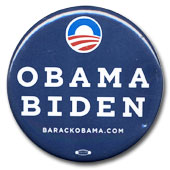
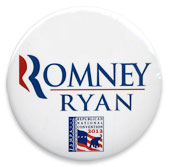 The quadrennial nominating conventions of the Democratic and Republican Parties continue to evolve. While their official purpose is to nominate the candidates of each party for President and Vice-President, the decision about who those candidates will be was made by the voters in the state caucuses and primaries many months earlier. There hasn't been a contested convention since 1952. Now their primary purpose is to formally launch the fall campaign with a big splash that will garner lots of media attention. In keeping with this shift in purpose, the dates of the convention have migrated from June to around Labor Day - the traditional beginning of campaign season. The actual dates are dictated by sporting events. The conventions avoid meeting too close to the Olympics,which would divert media and audience attention.Since sports arenas are the only places big enough for the thousands of people who want to attend, convention planners have to work around the team schedules of the host cities.The one constant is that the party of the President holds its convention after that of the other party.
The quadrennial nominating conventions of the Democratic and Republican Parties continue to evolve. While their official purpose is to nominate the candidates of each party for President and Vice-President, the decision about who those candidates will be was made by the voters in the state caucuses and primaries many months earlier. There hasn't been a contested convention since 1952. Now their primary purpose is to formally launch the fall campaign with a big splash that will garner lots of media attention. In keeping with this shift in purpose, the dates of the convention have migrated from June to around Labor Day - the traditional beginning of campaign season. The actual dates are dictated by sporting events. The conventions avoid meeting too close to the Olympics,which would divert media and audience attention.Since sports arenas are the only places big enough for the thousands of people who want to attend, convention planners have to work around the team schedules of the host cities.The one constant is that the party of the President holds its convention after that of the other party.
Security
Messaging
Press
Speakers
Women
Meetings
Protests
Once conventions ceased to be deliberative bodies, they became four-day forums, with a particular order of business: credentials challenges on Monday; platform discussions on Tuesday; nominations and voting on Wednesday; acceptance speeches on Thursday. Throughout the 1970s and 1980s there were highly publicized conflicts over credentials and the platform. The parties didn't like the negative publicity these generated so over time they tried to move disputes out of sight. The conventions ceased to be places where anything was openly discussed and became shows.
In 2012 the conventions were held in Tampa Bay, FL and Charlotte, NC. Having become more festivals than forums, they were appropriately reduced to three days. The Republicans had planned a four-day convention, but it was shortened by Hurricane Isaac (which gave Tampa only a big wet kiss on Monday as it rushed off to embrace New Orleans). The Democrats only scheduled three days of meetings. Thursday was to be a public celebration of the President, concluding with his acceptance speech in an outdoor stadium for 60,000 people. The venue was moved because Charlotte was repeatedly doused by short but violent rainstorms throughout the week. Since umbrellas were prohibited inside the arenas, the speeches had to move inside so the audience would not get soaked. In the end, Mother Nature overruled months of planning by both parties.
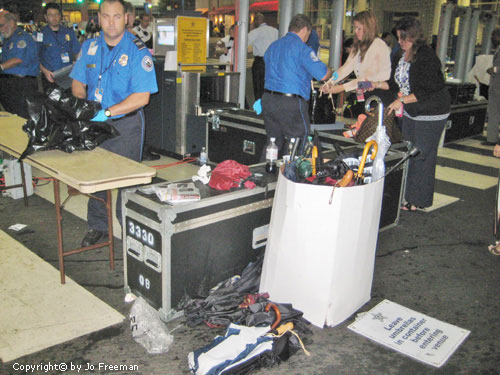
|
|---|
Security
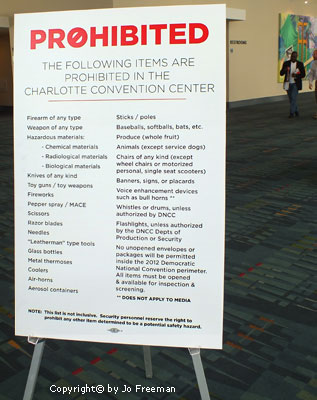 Security concerns dominated both conventions even more than previous ones. The 50,000 people who came to revel in the political spectacle were greeted by concrete barriers, steel mesh fences and 5,000 police. Many blocks around the meeting and working places were put in security zones, where entry was a challenge. There were numerous credentials checks on the way to the search wands and metal detectors, where a long list of prohibited items were confiscated.
Security concerns dominated both conventions even more than previous ones. The 50,000 people who came to revel in the political spectacle were greeted by concrete barriers, steel mesh fences and 5,000 police. Many blocks around the meeting and working places were put in security zones, where entry was a challenge. There were numerous credentials checks on the way to the search wands and metal detectors, where a long list of prohibited items were confiscated.
The security plans were designed by the Secret Service, which sees no benefit to ease of access. As barriers went up in both convention cities, it became harder and harder for anyone, with or without credentials, to go from place A to B. Indeed the security maze and numerous check points appeared to be designed both to induce stress and to relieve it with lots of walking.

|
|---|

|
Although the 2012 Democratic convention advertised itself as the most open and accessible in history, it was the least open and accessible of the 14 conventions I have been to. All the barricades and security provisions made it hard to go anywhere, even to events open to the public. The security perimeter was larger than that in Tampa, though outside the security zone there was less of a dampening effect. Most of downtown Tampa looked like a ghost town populated by uniforms; the streets of Charlotte were bustling. Offsetting the numerous physical barriers and sometimes ridiculous rules, the cops in both cities were pleasant and arrests were few.
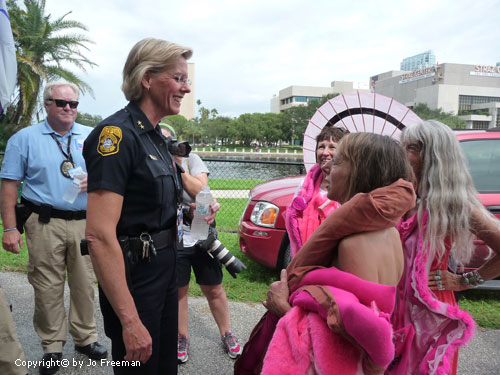 CodePink's Medea Benjamin praises Tampa Police to Chief Jane Castor. |
|---|
Messaging
Convention planners select the messages they want the TV audience to absorb. Some of these messages are obvious; some are subtle. They are emblazoned on the walls of the convention bowl and printed or painted on signs to be waved by delegates.
The Republican convention had a different message every day.
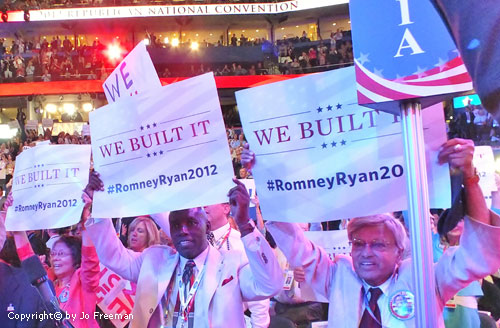 Tuesday's message. |
|---|
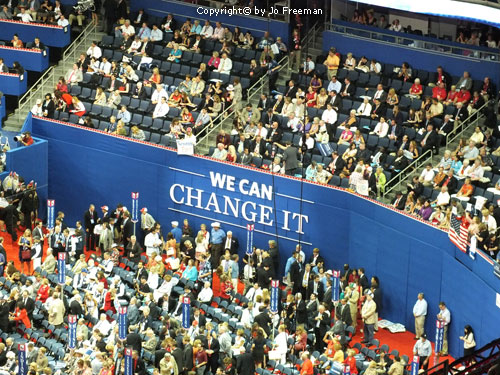 Wednesday's message. |
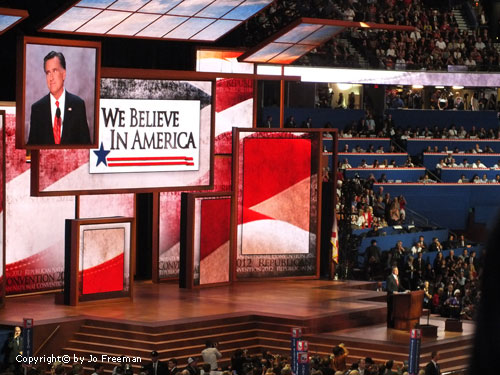 Thursday's message. |
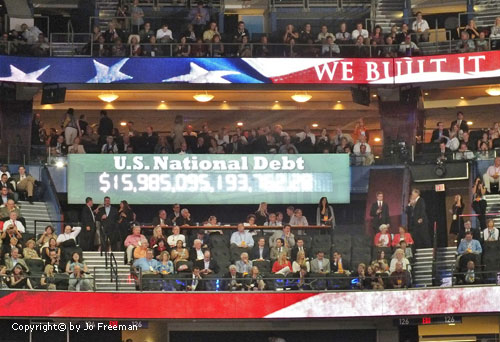 A constant message was this sign showing how much the national debt was increasing. The clock was started on Monday when the convention was gaveled in for ten minutes so it could be recorded as having officially met on that day. |
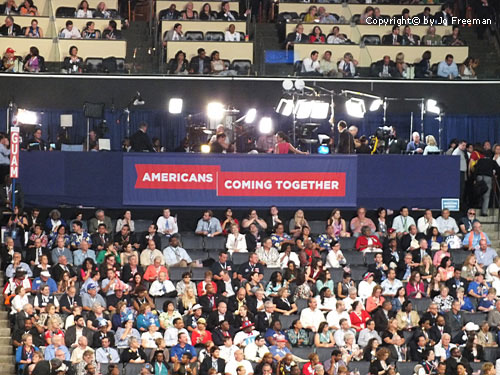 The Democrats stayed with the same primary theme throughout the convention. |
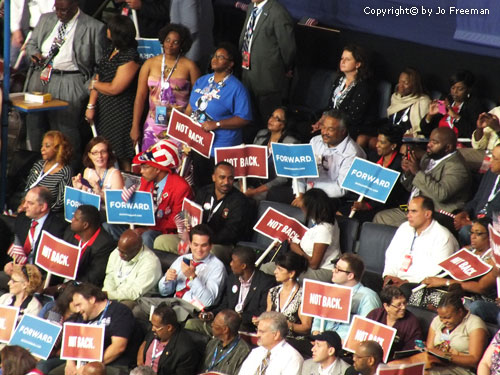 They used signs for secondary themes. |
 The Democrats also waived a lot of flags. Flag waving is much more common in Democratic than in Republican conventions. |
To Top
Books by Jo | What's New | About Jo | Photos | Political Buttons
Home | Search | Links | Contact Jo | Articles by Jo